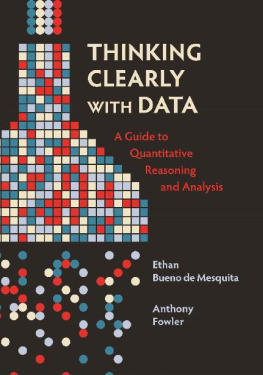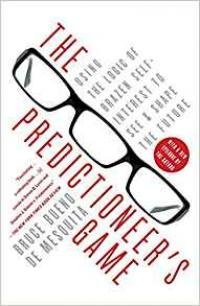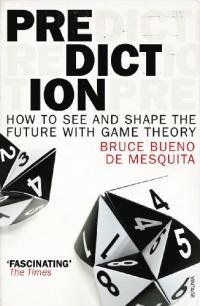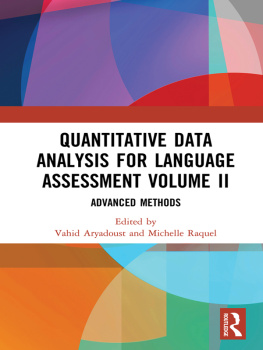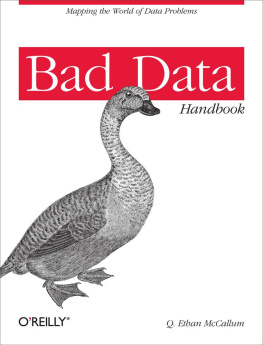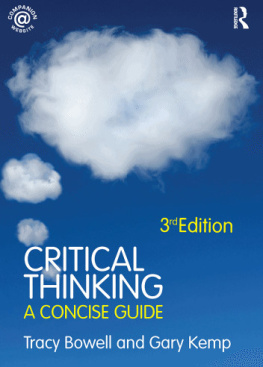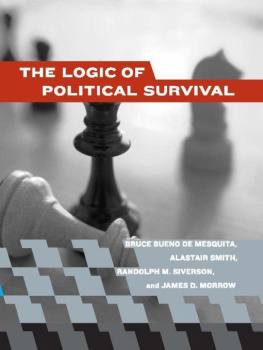Ethan Bueno de Mesquita - Thinking Clearly with Data: A Guide to Quantitative Reasoning and Analysis
Here you can read online Ethan Bueno de Mesquita - Thinking Clearly with Data: A Guide to Quantitative Reasoning and Analysis full text of the book (entire story) in english for free. Download pdf and epub, get meaning, cover and reviews about this ebook. year: 2021, publisher: Princeton University Press, genre: Politics. Description of the work, (preface) as well as reviews are available. Best literature library LitArk.com created for fans of good reading and offers a wide selection of genres:
Romance novel
Science fiction
Adventure
Detective
Science
History
Home and family
Prose
Art
Politics
Computer
Non-fiction
Religion
Business
Children
Humor
Choose a favorite category and find really read worthwhile books. Enjoy immersion in the world of imagination, feel the emotions of the characters or learn something new for yourself, make an fascinating discovery.
- Book:Thinking Clearly with Data: A Guide to Quantitative Reasoning and Analysis
- Author:
- Publisher:Princeton University Press
- Genre:
- Year:2021
- Rating:5 / 5
- Favourites:Add to favourites
- Your mark:
- 100
- 1
- 2
- 3
- 4
- 5
Thinking Clearly with Data: A Guide to Quantitative Reasoning and Analysis: summary, description and annotation
We offer to read an annotation, description, summary or preface (depends on what the author of the book "Thinking Clearly with Data: A Guide to Quantitative Reasoning and Analysis" wrote himself). If you haven't found the necessary information about the book — write in the comments, we will try to find it.
Thinking Clearly with Data: A Guide to Quantitative Reasoning and Analysis — read online for free the complete book (whole text) full work
Below is the text of the book, divided by pages. System saving the place of the last page read, allows you to conveniently read the book "Thinking Clearly with Data: A Guide to Quantitative Reasoning and Analysis" online for free, without having to search again every time where you left off. Put a bookmark, and you can go to the page where you finished reading at any time.
Font size:
Interval:
Bookmark:
Thinking Clearly with Data
Thinking Clearly with Data
A Guide to Quantitative Reasoning and Analysis
ETHAN BUENO DE MESQUITA ANTHONY FOWLER
PRINCETON UNIVERSITY PRESS
Princeton and Oxford
Copyright 2021 by Princeton University Press
Princeton University Press is committed to the protection of copyright and the intellectual property our authors entrust to us. Copyright promotes the progress and integrity of knowledge. Thank you for supporting free speech and the global exchange of ideas by purchasing an authorized edition of this book. If you wish to reproduce or distribute any part of it in any form, please obtain permission.
Requests for permission to reproduce material from this work should be sent to
Published by Princeton University Press
41 William Street, Princeton, New Jersey 08540
6 Oxford Street, Woodstock, Oxfordshire OX20 1TR
press.princeton.edu
All Rights Reserved
Library of Congress Cataloging-in-Publication Data
Names: Bueno de Mesquita, Ethan, 1974 author. | Fowler, Anthony, author.
Title: Thinking clearly with data: a guide to quantitative reasoning and analysis / Ethan Bueno de Mesquita and Anthony Fowler.
Description: 1st. edition. | Princeton: Princeton University Press, 2021. | Includes index.
Identifiers: LCCN 2021011897 (print) | LCCN 2021011898 (ebook) | ISBN 9780691214368 (hardback) | ISBN 9780691214351 (paperback) | ISBN 9780691215013 (epub)
Subjects: LCSH: SociologyStatistical methods. | SociologyMethodology.
Classification: LCC HM535.B84 2021 (print) | LCC HM535 (ebook) | DDC 302.01/5195dc23
LC record available at https://lccn.loc.gov/2021011897
LC ebook record available at https://lccn.loc.gov/2021011898
Version 1.0
British Library Cataloging-in-Publication Data is available
Editorial: Bridget Flannery-McCoy, Alena Chekanov
Jacket/Cover Design: Wanda Espaa
Production: Erin Suydam
Publicity: Kate Hensley
Copyeditor: Elizabeth J. Asborno
Cover image: Igor Kisselev / Alamy Stock Vector
Ethan: for Abe and Hannah
Anthony: for Gloria
- xvii
- xvii
- xviii
- xix
- xx
The world has changed in transformative ways. Data and evidence are ubiquitous. Quantitative information suffuses our talk of everything from policy to health care to job searches to politics to sports to education to dating to national security.
As a result, statistics and quantitative reasoning must no longer be the purview of only those who have a knack for mathematics or are headed for technical careers. Acquiring competence in foundational quantitative reasoning is now a fundamental responsibility of every educated human being and citizen. And this necessitates new ways of teaching and learning.
It was with that goal in mind that we decided to write Thinking Clearly with Data. But we didnt start with the book. Much of the material and ideas that ultimately found their way into the coming chapters were first developed for courses aimed at providing to students with little technical background the tools needed to be serious, thoughtful, and skeptical consumers of quantitative information. These courses include traditional university offerings, like introductions to quantitative reasoning taught to both undergraduate and graduate students at the University of Chicago. But they also include executive education courses offered to policy makers, military officers, national security experts, intelligence professionals, and journalists.
We learned a lot of lessons along the way that inform the choices we made in writing and organizing this book. Perhaps the most important was to create a shared language.
We knew we didnt want to teach a traditional statistics course. Such courses, in our view, are often too technical for many students and dont get to the most important and interesting issues, the ones that really matter for using quantitative information to make our lives and the world better. So, it was tempting to jump as quickly as possible to the exciting topics, like why correlation doesnt imply causation. But that would have been a mistake. A person cant understand why correlation doesnt imply causation until they understand what correlation and causation are.
For that reason, of this book is all about establishing a shared language. We define, conceptually and technically (but still accessibly), what we mean when we talk about correlation and causationnot in the sense of how to calculate a correlation coefficient or how to write down a causal effect in potential outcomes notation (though both will be covered), but in the sense of the questions, What do the words, properly understood and digested, mean in plain English? Whats hard about correlation and causation? Why are they usefully separated? What are these two kinds of things, correlations and causal relationships, good for?
But what about the problem of motivation? If you dont put the good stuff up front, how do you keep people engaged? Well, first, who says a conceptual understanding of what causality does and does not mean isnt the good stuff? It is great stuff. But, more to the point, our approach is this: if you want people to be engaged, make the material engaging. To us, this means several things.
The first is to tell stories. Throughout, you will find every conceptual discussion augmented by at least one extended, genuine, real-world example. Some of those examples will be about scientific studies. Many will be about personal experiences of ours where thinking clearly about quantitative evidence made a difference in the decisions we made. Others will involve reflections on the use of data and evidence in news, sports, policy, health care, and culture. This stuff really matters for how lives are lived and decisions are made in every realm of human endeavor. We want to keep that fact in the foreground. That is also why, despite the fact that this is a book by two political scientists, many of the examples are not drawn from politics.
The second way to engage readers is to emphasize ideas first and technicalities second. We love technicalities. But technicality can often be the enemy of understanding. When things get technical, lots of people stop thinking and start memorizing. We fervently wish to avoid that. So we always talk about the ideas and why they matter first. We treat things graphically whenever we can. And we do as little math as possible. But as little as possible isnt zero, for at least two reasons.
Familiarity with some technical matters is part of being a clear thinker. You cant understand mean reversion if you dont know what a mean or noise is. You cant understand publication bias and the replication crisis if you dont know what statistical significance means or what a p-value is. And it is hard to understand the problem of confounding or the answers offered by different research designs without being able to interpret a regression.
Moreover, sometimes being clear and precise requires a bit of math. We spend lots of time talking conceptually about counterfactuals and causality. But counterfactual talk can get a bit mystical. There is an extra degree of clarity that comes from writing down some potential outcomes and a proper definition of an effect that we think is indispensable. So we do not dispense with it. But, always, our emphasis is on clear thinking.
A third lesson for engaging writing is that it isnt enough for each chapter or lesson to tell a story. The whole course (or book) must do so. For us, the story is that making good decisions and doing good in our data-driven age requires clear thinking from each and every one of us. We cant just leave it to the experts, for many experts were never taught to think clearly about quantitative information. So we have to do it for ourselves or we will be frequently misled and may well make terrible mistakes.
Next pageFont size:
Interval:
Bookmark:
Similar books «Thinking Clearly with Data: A Guide to Quantitative Reasoning and Analysis»
Look at similar books to Thinking Clearly with Data: A Guide to Quantitative Reasoning and Analysis. We have selected literature similar in name and meaning in the hope of providing readers with more options to find new, interesting, not yet read works.
Discussion, reviews of the book Thinking Clearly with Data: A Guide to Quantitative Reasoning and Analysis and just readers' own opinions. Leave your comments, write what you think about the work, its meaning or the main characters. Specify what exactly you liked and what you didn't like, and why you think so.

